女性主义理论流派综述
- 格式:doc
- 大小:44.00 KB
- 文档页数:5
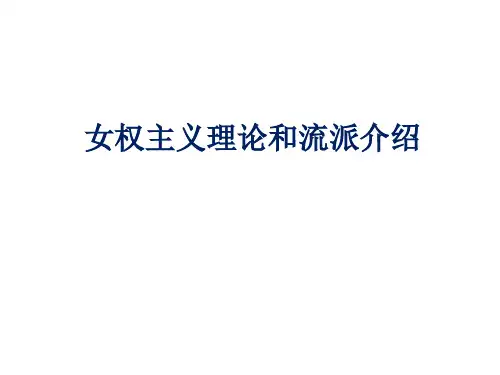
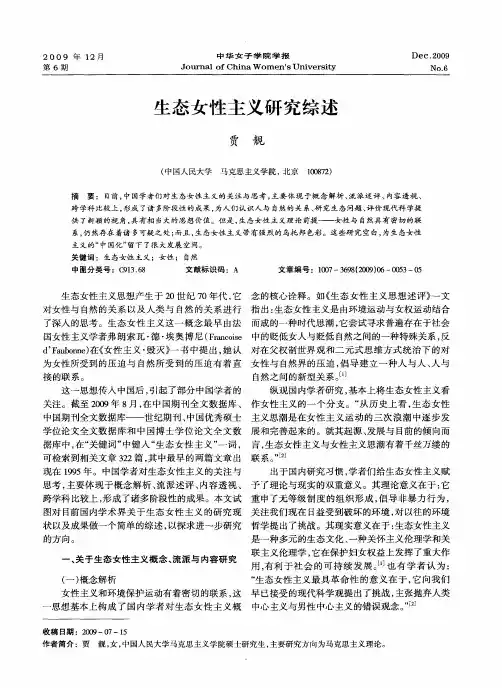
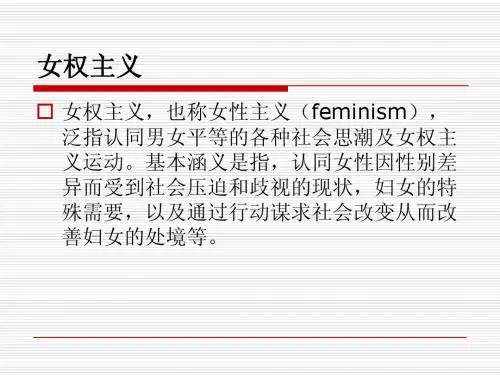
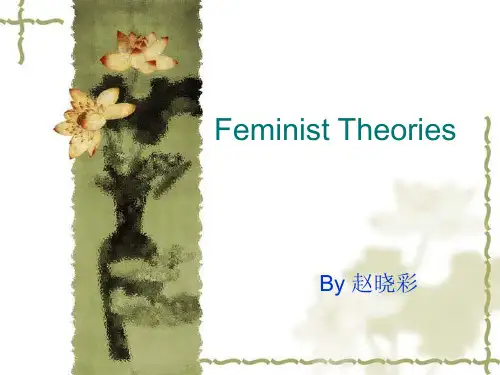
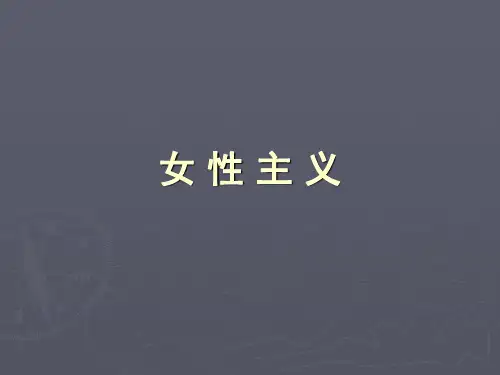

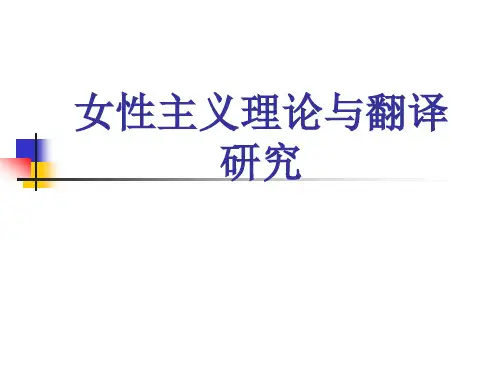
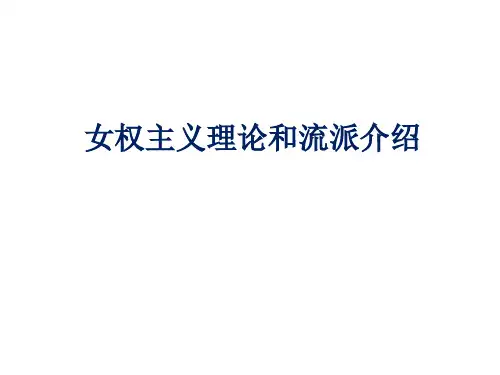
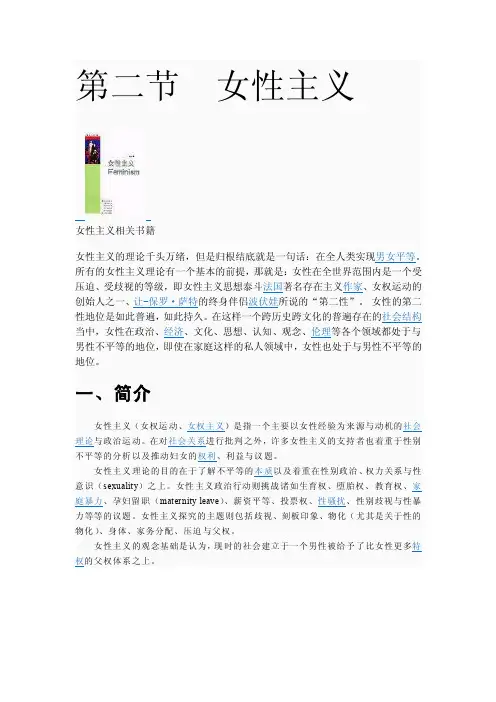
现代女性主义理论主要、但并非完全地出自于西方的中产阶级学术界。
不过,女性主义运动是一个跨越阶级与种族界线的草根运动。
每个文化下面的女性主义运动各有其独特性,并且会针对该社会的女性来提出议题,比如苏丹的性器割除(genital mutilation,请见女性割礼)或北美的玻璃天花板效应(glass ceiling)。
而如强奸、乱伦与母职则是普世性的议题。
二、发展背景女权主义是跟男女分工等值,妇女权益相联系的。
妇女解放运动到今天为止,大致可以分为三个阶段:第一次妇女解放运动大概是19世纪末左右,是妇女解放运动的第一次浪潮,当时争论的一个焦点是要求性别包括男女之间的生命全历程平等,也就是两性的平等,当时也要求公民权、政治权利,反对贵族特权。
反对一妻多夫、一夫多妻,强调男女在智力上和能力上是没有区别的。
女性主义最重要的一个目标是要争取家庭劳动与社会劳动等价、政治权利同值,往往被称作“女格运动”。
第二次妇女解放运动一般地说,是从20世纪60年代-70年代开始的。
人们认为,最早也是起源于美国。
这次运动一直持续到80年代。
其基调是要强调两性间分工的自然性并消除男女等工不同酬谢。
要求忽略把两性的差别看成是在两性社会关系中,女性附属于男性的基础的观点。
要求分领域对相应适可公众开放,等等。
第二次女权主义运动带来的另外一个结果,就是对于性别研究,女性主义的学术研究兴起。
因此,也出现了形形色色的女性主义流派。
长久以来,西方社会是一个以男权霸权意识为中心的社会意识形态。
所以人们在这种意识形态中形成的概念使得他们从男权的角度来描述这个世界,并且把这种描述混同于真理,就是说,这种描述是千真万确的,是天经地义的。
而女对这些男女们人习以为常的概念提出了挑战。
尽管流派众多,但基本点是争取两性寿终平权,彻底消除女性受歧视剥削压迫乃至误对(Abusement)的坏状况。
第三次妇女解放运动提议女性自尊自省自爱自觉自理自治,要求男性辅助女性摆脱蒙昧和压制,走向等位同格。
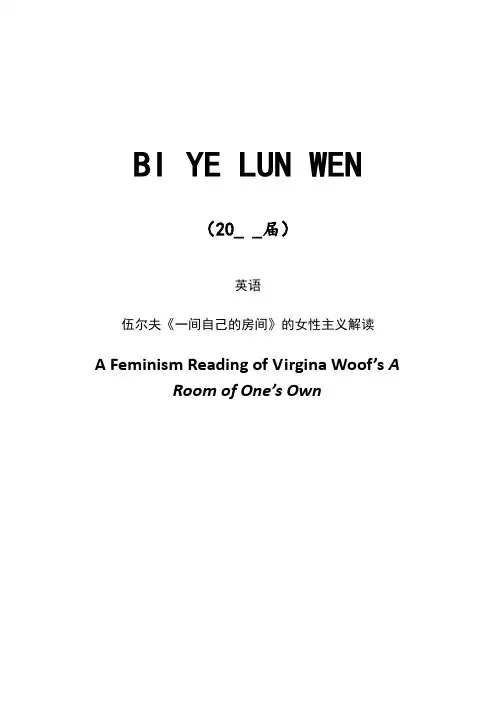
BI YE LUN WEN(20_ _届)英语伍尔夫《一间自己的房间》的女性主义解读A Feminism Reading of Virgina Woof’s ARoom of One’s Own内容摘要弗吉尼亚·伍尔夫是20世纪文坛上的一名杰出的女作家,她被尊为意识流小说的鼻祖之一,与乔伊斯、福克纳等意识流小说大师齐名。
同时,她又被尊为西方当代女性主义的“母亲”,她认为女性应该在经济上和精神上独立,并拥有自己的生活空间和精神空间。
此外,还要勇于表达自我的真实想法。
她认为女性主义的最终目的是消解两性之间的对立,以达到两者的和谐状态。
因此,她在《一间自己的房间》中提出了“双性同体”理论。
本文试图从女性主义角度解读《一间自己的屋子》,分析伍尔夫的女性主义思想,以期更好的理解文学中的女性主义。
伍尔夫的女性主义思想在21世纪的今天仍有极强的思考意义。
关键字:弗吉尼亚·伍尔夫;独立;空间;双性同体;女性主义AbstractVirginia Woolf is an outstanding woman novelist in 20th century. She has been regarded as one of the representatives of the stream of consciousness, enjoying equal popularity with Joyce and Faulkner. Meanwhile, she is regarded as the mother of modern feminism in the west. She thinks that females should be financially and spiritually independent and have their own living space and spiritual space. In addition, women also need to express themselves bravely and sincerely. She considers the final goal of feminism is to dispel the opposition between males and females and to reach a harmonious state. Therefore, she proposes the theory of androgyny in A Room of One's Own. This thesis tries to discuss A Room of One's Own from the angle of feminism, and analyze Woolf's feminism so as to seek a broader understanding of feminism literature in general. Studying Woolf still has a profound meaning in 21st century.Key words:Virginia Woolf; independence; space; androgyny; feminismContentsAbstract (ii)1 Introduction (4)2 What’s feminism (5)2.1 The etymology of the term "feminism" (6)2.2 T he definition of the term “feminism” (6)2.3 Virginia's concepts of feminism (7)3 Virginia’s feminist idea in A Room of One’s Own (7)3.1 Economic independence (8)3.2 Having a room of one's own (10)3.2.1 Living space (10)3.2.2 Spiritual space (11)3.3 Establishing female's value (11)3.4 The pursuit of androgyny (11)4 Factors leading to Virginia’s feminist view (14)4.1 Her parents’s influence (14)4.2 The Bloomsbury Group’s influence (16)4.3 Sexual Assault by her brothers (17)4.4 The Industri al Revolution and the Women’s Right Movement (17)5 Conclusion (18)Bibliography (47)Acknowledgements (18)1 IntroductionVirginia Woolf (1882-1941), is a famous woman novelist in the 20th century and she is one of the important modernist novelists. Meanwhile, she is one of the representatives of the stream of consciousness, enjoying equal popularity with Joyce and Faulkner. What's more, she is regarded as the mother of modern feminism in the west.Literary criticism of Virginia Woolf has proliferated since the1980s. Some critics appraise her works and some appraise her person; some analyze her work’s consciousness, and some analyze her feminism; some study her works from ethics, some from aesthetics, some from homosexuality, some from psychology. She is not only a great writer, but also a "forerunner, indeed the 'mother' of the contemporary Anglo-American feminism” as Zhu Gang describes. (Z hu Gang 2006: 342) As for her feminism, some criticize her feminism as an extreme type for they think her represented idea of feminism—androgyny means she intends to replace male value with female value; some criticize her deviating the feminism for they think she couldn't bear her own female identity, so she had to give up to the patriarchal society and swamped in the mud of utopian thought of androgyny; while the others praise it highly for it is an advancement in the stage of feminism's development.Xu Wei analyzes Woolf's feminism, both as a theoretical analysis of gender inequality and oppression, and as a political movement. Her paper analyzes that Woolf how to analyze the question of "women writing" in the theory and how to practice it in her writing. Woolf is concerned with the nature of womanhood. The focus on women characters in Woolf's fiction is central to much early feminist criticism, as well as non- or anti-feminist criticism. To an extent, "anger" and "androgyny" are the two terms most central to feminist debates on Woolf. Their centrality serves to further increase the importance of A Room of One's Own as the key text of Woolf's feminism and feminism's Woolf, for it is here that "anger" and "androgyny" are most fully discussed. And A Room of One's Own is seen by many critics to subdue and repress women's anger in favor of a more serene gender—transcendent or androgynous creativity. (Xu Wei, 2004: 38-39) Wu Qinghong tries to analyze, to show and to criticize Virginia's feminism in the development of western feminism. And she indeed did it, comprehensively andintensively. Her main viewpoint is that Virginia Woolf is the most important representative person in the history of feminism's development. Woolf's analysis on feminism corrected the shortage of feminism in 1890s to 1990s, which emphasized the equality between men and women on law. What's more, her feminism inspired the new feminist in 1960s and 1970s to deconstruct male's political and cultural supremacy and establish female's visual angle, which predicted the development direction of post-feminism in 1990s. (Wu Qinghong, 2005: 5) Ma Tingting draws a conclusion that Woolf's feminism is not a panacea for all women, but an occidental one with intense tendency of racialism.(Ma Tingting, 2006: i-ii) Wu Haixia probes the unique feminist thoughts of Virginia Woolf, which she thinks are quite different from most of the other feminists. It is clearly that since the appearance of feminism, the oppositions between men and women have been highlighted, and feminism is related to the marginalization of all women, with their being relegated to a secondary position. Most feminists hold their views that the social culture is a patriarchal culture. Woolf realizes that women are confronted with inequalities and exclusion in the patriarchal society. Woolf witnesses the efforts and achievements the feminists have made to get equal rights and positions with men, whereas she airs her view that the final goal of feminism is to deconstruct the binary oppositions between the two sexes. She presents her famous theory of "androgyny" in A Room of One's Own. She argues that androgyny is the best state of mind for writing, in which a writer can make perfect artistic expression. (Wu Haixia, 2007: ii)Woolf criticizes the patriarchal society in her works, and prompts us to reexamine the history of human by a female angle to create a new civilization. Her ideology and perception opens and enlightens the idea of feminism in many aspects. This paper tries to analyze Woolf's concepts of feminism through the reading of A Room of One's Own, to get a further understanding on feminism, which can also help deepen Chinese female’s comprehension of feminism.2 What’s feminismAt the very beginning of this paper, a basic question needs to be answered. That is what feminism is? In the academic circles of Europe and America, "feminism" generally refers to any activities to strive for and tick up for the right of females. It has several hundred years' history and has complex contents. Therefore, it is difficultto define it.2.1 The etymology of the term "feminism"The term "feminism" is derived directly from the Latin word fēmina,which means woman. This term and its derivatives originated in France during the late 19th century. The first person who called herself feminist was a French suffragette activist, Hubertine Auclert(1848-1914).She first used this term in her periodical called La Citoyenne in 1880.(Cai Qing, 2005: 3) However, although this term was used in her periodicals, it was not popular among women advocates who were rather moderate. Instead of "feminist", these women called their organization "feminine". It was not until the beginning of the 20th century when "feminism" became accepted by most women suffragette activists.2.2 The definition of the term “feminism”In broad sense, feminism can be defined as social movement, which takes eliminating sex discrimination and ending the oppression on women as its political goals. It also includes the revolution in ideology and culture which emerged from the process for pursuing its political goals. In this sense, feminists represent those who devote themselves in this movement sincerely, and any males and females who take part in the revolution of ideology and culture. In its narrow sense, feminism refers to a kind of methodology that regards and analyses a question in a gender perspective.Feminism now stands for a movement or philosophy that questions the unequal balance of power between men and women. Feminists fight for equality between men and women. The term "feminism" has become the name for the women's movement, the quest for social changes aimed at improving the position of women. Feminism is defined both as "the theory of the political, economic, and social equality of the sexes " and " organize activity on behalf of women's rights and interests".(Merriam-Webster, 2003: 461) Hence, the term feminism is not only about the struggle for political rights. It is a system of ideas and a social movement, directed towards opposing men's privilege of position and women's subordination. This term contains redistribution of power and recognition of sex equality.2.3 Virginia's concepts of feminismVirginia Woolf is not only a female writer, but also a pioneer of feminism. Her essential contribution to feminism is her perseverance that social and economic elements are critical to shape women's creativity and perception. According to her idea, women play a historical role to join in the creation of human civilization, especially the arts. What she emphasizes is that females should face the reality and think things that related to them instead of thinking things that concerned men. Therefore, she puts forward the idea that females should set up a literature of their own. To deal with the anger that appears in the process of writing and derives from the inequality between men and women, she proposes a concept of androgyny. An androgynous mind is the best state of mind for doing literary creation. However, it causes a heated debate among later feminists. Although it is controversial, she creates a bright future for females.Virginia's view of feminism is embodied intensively in the idea of androgyny. Androgyny has more than one meaning. It may refer to the anatomical coexistence of two sorts of sex organs in the same body; or else to the allegory of a form of spiritual perfection. In other cases, it is related to the explicit coexistence of male and female qualities in the same entity. (Wu Haixia, 2007: 23-24) To put it simply, androgyny means full balance and command of an emotional range that includes male and female elements. She thinks the final goal for feminism is to eliminate the opposition between males and females. Virginia's feminism includes economic independence, spiritual independence. Her analysis on feminism corrected the shortage of feminism in 1890s to 1990s, which emphasized the equality between men and women on law. What's more, her view of feminism inspired the new feminist in 1960s and 1970s to deconstruct male's political and cultural supremacy and establish female's visual angle, predicting the orientation of post-feminism in 1990s.3 Virginia’s feminist idea in A Room of One’s OwnA Room of One's Own is Virginia's representative work of feminism. In October, 1928, Virginia Woolf was invited to give two academic speeches by Cambridge University. One was in the Art Society of Newnham, the other was in the Gordon women college. The lecture topic was Women and fiction. The next year, she published a brochure,which was written on the basis of these two lectures. Quickly, the booklet amazed the world with a single feat at that time. Up to now, it has become the most famous work and has most readers compared to her other works. It is universally acknowledged as a declaration of western feminism.The work---A Room of One's Own can be divided into six parts. The first part describes an experience in Oxbridge University fabricated by the author, which shows an unfair treatment that females received in a patriarchal society. The second part represents a phenomenon that the author found a large amount of books about women's problems written by men in the England museum. What’s worse, one professor claimed absolutely in his marvelous work that female's intelligence, physical power and morality are all lower than males. In the third part, the writer sketches a hypothetical "Judith" Shakespeare, sister of William, who is as brilliant and promising as he, but her talent is undoubtedly buried by the patriarchal society. Woolf traced back to the females' rough process for getting in the literature arena in the forth part. Aphra Behn (1640-1689), a playwright, novelist and poet of England, who is the first English female to became a professional writer in 17th century. Then women writers began to feel proud and elated. However, most English women writers had to use males' name as pen names to relieve their social pressure during the 19th century. In the fifth part, the author points out that it is necessary to strengthen females' awareness of knowing the difference between males and females. Only in this way, she thinks, females can realize the true value of themselves. In the last part, Virginia agrees with Samuel Taylor Coleridge's androgynous idea, believing that a writer's creative soul should have both masculinity and femininity. In other words, a person is a bisexuality instead of a unisexuality. A person is androgynous. When full balance and command of an emotional range that includes male and female elements reached, these men writers or women writers can create great works.3.1 Economic independenceFemales are facing an economic problem. As is known to all, economy is the basis of living. Women lose their economic source, when the patriarchal society excludes them from the public work, which causes them sink in a poor state. In reality, what females are engaged in are human beings' personal production and all kinds of necessary house works to maintain many families’ functions. When women are doingthese, they use up their physical power, energy, and even sacrifice their lives. However, these are all done in the area of family. Their yields often cannot leave any tangible fruits. For example, the cooked food will be eaten up, the washed clothes will be dirty after wearing again, and children who have been raised up will leave home to get in their own world. Don't these household labors have any value? Is there anybody who pays them salary? Therefore, these natural, non-commercial labors are excluded from the social labor by the patriarchal society, because they are only related with personal family members and they cannot create value directly. Since the unpaid labor take up most energy of females, they lose their subject position in the society and lose the source of finance. Therefore, if females want to get rid of the disadvantaged status imposed on them by history and reality, they should strive for the economic position. Just like what Woolf says in A Room of One's Own, women should have revenue of 500 pounds every year. She considers that the main reason why there are so less women writers is that our mother is too poor. For example, if Mary's mother " had gone into business; had become a manufacturer of artificial silk or a magnate on the Stock Exchange; if she had left two or three hundred thousand pounds to Fernham, we could have been sitting at our ease tonight and the subject of our talk might have been archaeology, botany anthropology, physics, the nature of the atom, mathematics, astronomy, relatively, geography. If only Mrs. Seton and her mother and her mother before her had learnt the great art of making money and had left their money, like their fathers and their grandfathers before them, to found fellowships and lectureships and prizes and scholarships appropriated to the use of their own sex, we might...have looked forward without undue confidence to a pleasant and honorable lifetime spent in the shelter of one of the liberally endowed professions. We might have been exploring or writing; mooning about the venerable places of the earth; sitting contemplative on the steps of the Parthenon, or going at ten to an office and coming home comfortably at half-past four to write a little poetry." (Virginia Woolf, 2005: 576) They haven't learned how to make money, how to manage their own property. For thousands of years, women are handling house works and rearing children, while men are doing business for making money. While princes and aristocrats use their properties to build many schools and libraries, women are rejected out of the colleges; they are restricted in a small circle of family. They have no rights to receive education. As a result of being deprived of enjoying rights of owning their ownproperty, females' desires for making money are constrained. The thousands of years' influence of patriarchal society places women in a penniless position.Women began to walk out of the household in 20th century. Thus, many women writers sprung up. We can see that for the latest hundred years, the appearance of many women writers are concerned with the rights women have achieved, especially the acquirement of economic right, which plays an important and positive role in art creating. Woolf herself also admitted that she and her sister obtained all their father's books after their father's death, so she could start her writing career. In A Room of One's Own, the narrator also repeatedly says that but for her aunt's 500 pounds' heritage, it might have been hard for her to break away most women's fate---working hard in the household or going out for earning money to keep the pot boiling. All in all, females should be independent in the economy.3.2 Having a room of one's ownVirginia said that “a woman must have money and a room of her own if she is to write fiction." (Virginia Woolf, 2005: 555) It has been discussed that females should be financially independent. Now, it turns to a room of one's own. Having a room of one's own not only indicates that females should have their basic living space, but also means that females should have a comparatively free spiritual space.3.2.1 Living spaceIn the past, women were restrained in a small room, being busy at doing trivial house works all day. It was not uncommon that their works would be suspended. What's worse, they had to hide their works quietly to avoid being scoffed. Jane Austen is a good example in A Room of One's Own." For she had no separate study to repair to, and most of the work must have been done in the general sitting-room, subjecting to all kinds of casual interruptions. She was careful that her occupation should not be suspected by servants or any persons beyond her own family. Jane Austen hid her manuscripts or covered them with a piece of blotting-paper." (Virginia Woolf, 2005: 604) Therefore, having a living space for one's own plays an essential role in females' creation.3.2.2 Spiritual spaceMany women writers were born in rich families. They had money and their own living spaces. However, they depended on their parents so much that they didn't go out for traveling to broaden their eyes. They did what their fathers asked and even married to who their fathers picked for them. When they were children, they were subjected to their fathers; when they were married, they were obedient to their husbands; when they were old, they complied with their sons. It is just like the three cardinal guides and the five constant virtues as specified in the ancient Chinese feudal ethical code. Women never had their own minds and their own spiritual space, they were not spiritually independent. Woolf pays more attention to the influences of patriarchal society on women's writing.3.3 Establishing female's valueWoolf finds that women's writing hasn't had their own tradition. Therefore, she proposes that females should set up their own value. To create females' literature or other careers, they have to take two times adventures. First of all, killing the "angel in the house", to be ourselves. Here, the "angel in the house" represents the stipulations that imposed on women by social norms and ideology of traditional culture. It also refers to females' conscious compliance to this oppression. They even turned patriarchal oppression and forbidden into their self requests and self-conscious actions. Facing this, Woolf realizes that the only way is to kill it, otherwise "she will kill me, she will dig out my heart of writing". The second adventure is to express truly the physical experience of ourselves. Women's requests suffered an extreme suppression and twist in the patriarchal society. According to Woolf, the consciousness that how a man will look at a woman who expresses her own real lust disturbs a female writer's imagination and damages her creativity. Therefore, expressing one's own real idea becomes an important means to remove the patriarchal ruling.3.4 The pursuit of androgynyAndrogyny is Woolf's social and literary ideal, but its premise is getting rid of the two sexes inequality and opposition, and the discrimination on females. Many feministsare unwilling to accept this viewpoint. For example, Elaine Showalter points out that "Woolf's androgyny is a female writer's reaction to her crag-fast condition". (Zhugang, 2006: 355) It is a utopia imagination of an ideal artist. Although it is quite controversial, it is a revolt to the creative standpoint of literature which regards male value as the unique standard. It is an initial deconstruction to the binary opposition of sex. It has a great influence on the generation of subsequent feminism theory and its criticism.Androgynous mind is central to Woolf's feminism. She defines it as "a mind that is reason; that transmits emotion without impediment; that is ceaselessly creative; incandescent; undivided. In fact one goes back to Shakespeare's mind as the type of the androgynous, the man-womanly mind." (Huangzhong, 2005: 23-24) Simply speaking, androgyny means full balance and command of an emotion range that includes male and female elements. She thinks that an androgynous mind is the best state of mind for doing literary creation.Woolf proposes at the beginning that "a woman must have money and a room of her own if she is to write fiction." (Virginia Woolf, 2005: 555) However, she also points out that the economic problem is not the only element that impacts women's writing. A placid and healthy state of mind is also necessary. The narrator takes Lady Winchester as an example in the 4th chapter of A Room of One's Own. She was noble both by birth and by marriage; she was childless; she wrote poetry. Her mind was disturbed by alien emotions like fear and hatred, so her poems showed traces of that disturbance:How we are fallen! fallen by mistaken rules,And Education's more than Nature's fools;Debarred from all improvements of the mind,And to be dull, expected and designed;And if someone would soar above the rest,With warmer fancy, and ambition pressed,So strong the opposing faction still appears,The hopes to thrive can ne'er outweigh the fears.Yet it is clear that could she have freed her mind from hate and fear and not heaped it with bitterness and resentment, she could create pure poetry as follows:Nor will in fading skills compose,Faintly the inimitable rose. (Virginia Woolf, 2005: 599-600)Charlotte Brontěmay be another example. As we all know, she is an brilliant English novelist. However, Woolf finds that there is a certain shrillness arising out of her works. Although Woolf thinks that she is more genius than Jane Austen, her anger makes her books "deformed and twisted" (Virginia Woolf, 2005: 606). There is no doubt that a woman writer would become angry in a man-dominated society. She expresses her dissatisfaction in her famous work---Jane Eyre: “Women are supposed to be very calm generously: but women feel just as men feel; they need exercise for their faculties and a field for their efforts as much as their brothers do; they suffer from too rigid a restraint, too absolute a stagnation, precisely as men would suffer..." (Virginia Woolf, 2005: 606) As a consequence," She will write in a rage where she should write calmly. She will write foolishly where she should write wisely. She will write of herself where she should write of her characters. She is at war with her lot. How could she help but die young, cramped and thwarted?" (Virginia Woolf, 2005: 606)On the other hand, Jane Austen had been constantly disturbed when writing Pride and Prejudice. Therefore, Woolf thinks that the environment should have influenced her and she would write a better one if there were no disturbances. To Woolf's surprise, when she "read a page or two to see, but I could not find any signs that her circumstances had harmed her work in the slightest." (Virginia Woolf, 2005: 605) She thinks that because Austen wrote "without hate, without bitterness, without fear, without protest, without preaching. That was how Shakespeare wrote." And "when people compare Shakespeare and Jane Austen, they may mean that the minds of both had consumed all impediments; and for that reason we do not know Jane Austen and we do not know Shakespeare, and for that reason Jane Austen pervades every word that she wrote, and so does Shakespeare. (Virginia Woolf, 2005: 605)What is the difference between these two groups of examples? We can see that in the last chapter of this essay. The narrator gets the inspiration when she sees a very ordinary sight out of the window: a girl and a young man are coming down the street, meeting at the corner and getting into a cab. Then she sketches a plan of the soul so that "in each of us two powers preside, one male, one female; and in the man's brain the man predominates over the woman, and in the woman's brain the woman predominates over the man. The normal and comfortable state of being is that when the two live in harmony together, spiritually co-operating. If one is a man,still the woman part of his brain must have effect; and a woman also must have intercourse with the man in her. (Virginia Woolf, 2005: 623-624) She thinks that perhaps what Coleridge meant when he said that a great mind is androgynous.4 Factors leading to Virgini a’s feminist viewVirginia Woolf is a productive writer and a great feminist, but first of all she is a social being, so her ideas can not be separated from the factors leading to her feminist view. As a result, it is far from enough to know about her and her work only by knowing her talents and achievements. Her parents and the Bloomsbury Group are of great influence on her writing and her feminist ideas. Besides, there are sexual assault by her brothers, the Industrial Revolution and the Women’s Right Movemen t.4.1 H er parents’ influenceVirginia Woolf was born in a literary family. Her father was the distinguished Victorian author, critic and Alpinist, Sir Leslie Stephen (1832-1904), editor of the Cornhill Magazine (1871-82), of the Dictionary of National Biography (1882-90) and of the Alpine Journal (1868-72), who counted Thomas Hardy, Henry James and George Meredith among his friends (Jane Goldman, 2008: 3). Her mother was Julia Prinsep Stephen (1846-95), who was born Julia Prinsep Jackson, in India, the daughter of John and Maria Jackson. Her maternal grandmother, and Woolf’s great-grandmother and namesake, was Adelin (1793-1845), daughter of Antoine Chevalier de L’Etang and Thérèse Blin Grincourt,who married James Pattle (1775-1845) of the Bengal Civil Service (Jane Goldman, 2008: 4). There is no denying that her parents exerted great influence on her thinking. She was born in a large and well-to-do family, with learned father and mother, intelligence and wide social connection.Her father, Leslie Stephen, a widower, had married Julia Jackson in 1878. Between them they already had four children; after they got married, they had another four children: Vanessa, Thoby, Virginia and Adrian. This family was a typical patriarchal family of Victorian time. In the family, the patriarchs were in charge of everything, owing unassailable powers, capable of enforcing everything upon women. There is evidence in the article of Virginia Woolf and Leslie Stephen: History and。
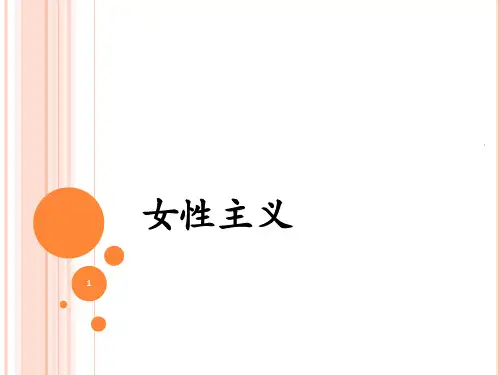
简介女性主义(Feminism)又称女权(女权主义)、妇女解放(女性解放)、性别平权(男女平等)主义,是指为结束性别主义(sexism)、性剥削(sexual exploitation)、性歧视和性压迫(sexual oppression),促进性阶层平等而创立和发起的社会理论与政治运动,批判之外也着重于性别不平等的分析以及推动性底层的权利、利益与议题。
女权主义是女性主义初级阶段的历史用语,两者本质没有区别女性主义的观念基础是认为,现时的社会建立于以男性为中心的父权体系之上。
女性主义理论的目的在于了解不平等的本质以及着重在性政治、权力关系与性意识(sexuality)之上。
女性主义政治行动则挑战诸如生育权、堕胎权、教育权、家庭暴力、产假、薪资平等、投票权、代表权(Representation politics)、性骚扰、性别歧视与性暴力等等的议题。
女性主义探究的主题则包括歧视、刻板印象、物化(尤其是关于性的物化)、身体、压迫与父权。
女性主义运动是一个跨越阶级与种族界线的社会运动。
每个文化下面的女性主义运动各有其独特性,并且会针对该社会的女性来提出议题,比如苏丹的性器割(genital mutilation)或北美的玻璃天花板效应,以及中国的女性参政问题、女性劳动报酬偏低的问题;女性下岗失业比例偏高的问题;流产和遗弃女婴问题;婚后居住在男方家所带来的男女不平等问题;媒体和社会观念中的父权(男权制度)(Patriarchy)思想残余问题等。
而如强奸、乱伦与母职则是普世性的议题。
女性主义的理论千头万绪,归根结底就是一句话:在全人类实现男女平等。
综观女性主义的理论,有些激烈如火,有些平静如水,有些主张做决死抗争,有些认可退让妥协,但是所有的女性主义理论都有一个基本的前提,那就是:女性在全世界范围内是一个受压迫、受歧视的等级。
综述女性的第二性地位是如此普遍,如此持久。
在这样一个跨历史、跨文化的普遍存在的社会结构当中,女性在政治、经济、文化、思想、认知、观念、伦理等各个领域都处于与男性不平等的地位,即使在家庭这样的私人领域中,女性也处于与男性不平等的地位。
女性主义理论女性主义理论是指一系列关于女性权利和社会地位的观点、理论和观念的学术体系。
它涉及了对女性在社会、政治、经济和文化领域中的地位和权利的探讨与争取。
女性主义理论源自对性别不平等和性别歧视的反对,试图通过批判和重构现有的社会体制来实现性别平等和女性权利的保障。
在全球范围内,女性主义理论以不同的形式和理论框架发展,展现出多样性和丰富性。
历史回顾女性主义理论的发展经历了不同阶段和演变过程。
19世纪中期至20世纪初是第一波女权主义运动的兴起时期,关注于争取妇女的政治权利和社会地位。
而在20世纪中叶,第二波女权主义运动揭示了性别歧视的深层结构,并追求性别解放和性别平等。
此后,第三波女权主义运动兴起,强调多元化和包容性,关注性别、种族、阶级、性取向等多重身份认同的交织。
核心理论观点女性主义理论包含了丰富多元的理论观点和范式,其中一些核心理论观点包括:- 结构性性别歧视理论:揭示社会体制中根深蒂固的性别歧视结构,强调性别是社会建构的产品。
- 父权制批判:批判父权制作为社会组织原则对女性的压迫和限制。
- 后现代女性主义:探讨性别认同、权力关系和文化表达的复杂性,强调个体和主体性的反思与实践。
- 生态女性主义:强调社会、经济和环境的整体性,指出性别平等与生态平衡的密切联系。
当前挑战与反思尽管女性主义理论取得了重要的成就和影响,但在当今社会仍面临种种挑战和困境。
性别暴力、职场性别歧视、性别薪酬差距等问题依然存在,需要持续关注和努力。
同时,多元文化和全球化背景下的女性主义面临着认同、包容和传统文化的挑战,如何在多元文化交织的当代社会中维护女性权益和实现性别平等仍需深入探讨和实践。
未来展望在未来,女性主义理论将继续面临各种挑战和机遇。
随着社会的不断变革和发展,性别角色和性别认同的多样性将得到更多关注和重视。
女性主义理论需要不断创新和适应时代的变迁,引领性别平等与女性权益保障的发展。
综上所述,女性主义理论是现代社会中一个重要的思想体系,它关注着性别平等、女性权益和社会变革。
女性主义理论流派综述摘要:女性主义是一股影响力相当大的思潮,近年来国内学者开始逐渐的关注西方的女性主义问题,并发表了许多的文章对这些不同的流派进行介绍。
本文选取了西方女性主义影响力较大的几个理论流派,并概述了一些学者对这些流派的评价与看法。
关键词:女性主义;性别差异;不平等引言在人类的历史上,不论是西方社会还是中国社会,女性一直处于被压制的状态之下。
在父权体制长期的宰制之下,女性一直被男性视为私有财产,且不能发挥其聪明才智。
在中古时期的欧洲,才智出众的女子会被冠以女巫的标志,而中国自古便宣扬女子无才便是德和三从四德等伦理。
在这样的社会背景当中,女性并不是一个完整的个体,她们依附于男性而存在。
但随着社会的发展和观念的进步,女性对于权利、平等和自由的要求和呼声也越来越高。
最终,女性意识的觉醒逐渐触发了女性主义的浪潮。
第一次女性主义浪潮爆发于18世纪下半叶至1925年,运动的目标在于争取与男性平等的政治权利,包括话语权、教育权、就业权和反对一夫多妻制等。
一般来说,第二次女性主义浪潮产生于二战后的60-70年代,其基调是要强调两性间分工的自然性并消除男女等工不同酬。
要求忽略把两性的差别看成是在两性社会关系中,女性附属于男性的基础的观点。
要求分领域对相应适可公众开放,等等。
第三次女性主义浪潮产生于世纪之交,具有地方性、人身性、差异性的特点。
这次浪潮把注意力放到主体性和活生生的身份认同上,号召在各个相异的人群之间要有真诚的倾听和交流,而并不是把自己的解释图示强加给别人。
这次运动中还使女性主义者认识到,要取得实质性的进展,不仅需要世界范围内广大女性的支持,还必须争取作为人类另一半的男性的支持与配合。
前后的三次女性主义浪潮中不断的产生了纷繁复杂、观点各异的女性主义理论。
这些理论不仅直接的推动了女性主义的浪潮,同时也带给了人们一种全新的研究视角。
一、女性主义概念界定女性主义的英文是Feminism,是源自于法国的Feminisme。
根据柯德教授的研究,1880年代创立第一个妇女参政权会社的法国女子奥克雷最先提出了这一个词汇。
但是,直到二十世纪初年女性主义才被法国各派争取妇女选举权运动者所接受。
西蒙·波伏娃认为女性主义是独立于阶级斗争之外,专门为女性主义而斗争的主义①。
她认为女性主义者是在结合阶级斗争,但独立于阶级斗争之外,力求改变妇女处境的女性,甚至是男性。
凯特则认为女性主义指反抗举世用法律①西蒙·波伏娃.第二性【M】.西苑出版社,2009.5或习俗强行阻扰妇女享有自由的一切人为障碍。
她还认为,像启蒙思潮与民主政体一般,女性主义是一种进化,没有领袖,也无须组织,而且因各个地区的特殊需要与特定的宗旨而有不同的含意。
国内学者关于Feminism这一概念的确切含义和译法仍然存在争议。
一些学者将Feminism译为女权主义。
他们认为,Feminism自产生至今涉及的主要是男女之间在政治、经济、文化等方面的权利不平等问题,在这一问题得以解决之前的历史时期,采用女权主义的译法更为合适。
另一些学者则认为Feminism不应译为女权主义,而应译为女性主义,因为随着西方妇女运动的发展, Feminism 涉及的主要问题已不再是争取与男性平等的权利,而是女性自身如何发展完善的问题,因而译为女性主义更为贴切。
二、国内学者关于女性主义主要理论的评价(一)自由主义女性主义自由主义女权主义出现于16世纪的英国和法国,至今它仍有很多支持者。
它的主要代表人物是玛丽·沃斯通克拉夫特、约翰·斯图亚特·穆勒和贝蒂·弗里丹。
郤继红①、李银河②等人认为,自由主义女权主义在一定程度上揭示了当时男女不平等的现实及其原因,并从女性也是具有理性的人这一假定出发,提出女性应拥有与男性平等的权利,这在理论上和实践上都有积极的意义。
她们将自由主义女权主义主要理论观点概括为:(1)男性和女性都是具有理性的个体,无论男性还是女性都应当享有作为人的一切法律和政治权利,都可以自由选择生活的角色。
(2)传统的价值观贬抑女性的社会作用,将女性的角色限于家庭和私人生活范围,因而女性只有摆脱传统观念的束缚,勇敢走出家庭和私人生活领域,才能在社会生活中实现自身的价值,在社会领域内获得男女平等。
(3)女性在社会和家庭中处于不利地位的一个重要原因是男女受教育机会的不均等,这导致了现实生活中女性和男性在理性上的差异,因而要改变女性的不利地位,就必须使女性获得与男性同等的受教育的机会。
(4)女性生育和抚养儿童的任务阻碍了她们与男性的公平竞争,要改变这一情况,就应使女性拥有自由选择生育的权利,并使男性与女性共同承担家庭责任。
自由主义女性主义的理论及其实践,对妇女的发展作出了贡献,但是它的资产阶级白人女性的立场,以男性价值为标准的妇女解放价值取向受到后来者的批评。
(二)马克思主义女权主义沃野③、王跃华、张国盛④认为马克思主义女权主义强调要从马克思主义出发分析女性问题,并在此基础上提出:①郤继红. 新马克思主义的女权主义理论【J】.马克思主义与现实,1996 ,(2).②李银河. 后现代女权主义思潮【J】.哲学研究,1996 ,(1).③沃野. 关于西方的马克思主义女权主义【J】辽宁教育学院学报,1995 ,(6).④王跃华,张国胜. 当代西方马克思主义女权主义【J】.国外社会科学,1997 ,(2).(1) 尽管女性之间在年龄、种族、社会经济状况、宗教方面存在种种差异,但她们都要从事满足人类物质生活需要的生产活动,因此必须根据她们在生产关系中的地位来说明她们的从属地位及其所受的剥削和压迫。
(2)女性受剥削和压迫的现象是随着私有制的出现而产生的,私有制使财富集中在少数人手中,而且最初都是集中在少数男性手中。
在当代,女性受剥削和压迫不仅由于父权制的存在,而且由于资本主义制度本身。
因此,女性要获得解放就必须以会主义代替资本主义,实现生产资料归全民所有,使女性在经济上获得独立。
(3) 尽管父权制先于资本主义制度存在,但后者的机制是维护男性对女性的优势地位的,所以既要反对父权制,又要反对资本主义制度。
社会主义女性主义者认为马克思主义存在社会性别盲点,没有把阶级概念和社会性别概念整合到同一个解释框架中,专注于剖析资本主义对妇女的侵害,却忽视了男人对妇女的压迫。
(三)激进主义女权主义激进主义女权主义产生于20 世纪60 年代英国、法国和美国,其主要代表是凯特·米丽特、杰曼·格里尔和舒米拉斯·费尔斯通。
与自由主义女权主义相比,激进主义女权主义在对男性中心社会的批判上取得了很大的突破。
国内学者郤继红、李银河等人认为激进主义女权主义所持的主要理论是:(1)性别压迫是其他社会压迫的核心和基础。
(2)性别压迫的主要根源在于父权制的社会结构和家庭结构,女性解放的关键在于粉碎父权制。
(3)国家是父权制的表现,家庭是一种社会制度,在家庭这种社会制度当中,女性劳动力受到男性的剥削。
批评者认为,激进女性主义对男人、女人做了本质主义的理解,把与性、生育、生物性母职相关问题两极化了。
实际上并非每个女人都是被压迫者,就像并非每个男人都是压迫者一样。
父权制是个有用的分析工具,可以为正在寻求攻击点的妇女找到一个攻击的方向,但超过了某个范围,父权制就变成了生硬的工具。
(四)生态女权主义生态女权主义产生于20 世纪80 年代的法国,其主要代表是卡罗琳·莫肯特、斯塔哈克和范达娜·西瓦。
随着生态问题研究的不断推广和深入,生态女权主义的思想也日益受到关注。
生态女权主义认为:女性和自然界在创造生命方面有着内在的联系,女性孕育生命、哺育后代的性别角色使她们与养育万物的大自然有特殊的亲近关系;男权统治者在压迫“自然化的女人”的同时,也在压迫“女人化的自然界”。
女权主义倡导创造新型的女性文化以激励和宏扬女性独特的天性,并认为对妇女的压迫和对自然的压迫有着直接的联系,其中一方的解放不能脱离另一方的解放①。
①Karen J.Warren.Feminism and Ecology【J】.Environmental Review ,1987,(1) : 3 – 201.(五)后现代女性主义后现代女权主义思潮出现于20 世纪70 年代的美国和法国,其主要代表人物有琳达·奥尔克芙和埃莱娜·西苏。
后现代女性主义者从存在主义者西蒙·波伏娃、解构主义者德里达和精神分析家拉康那里受到启发。
她们接受波伏娃的妇女是“第二性”这一结论,但认为没必要去超越妇女的他者性,因为他者的处境可以使妇女以局外人的立场批评主流文化的社会规范、价值和实践。
她们吸取了解构主义者的思想精髓,认为源自象征秩序的语言使女人和他者的一切都没有得到讨论。
她们拒绝运用象征秩序语言的阳性写作,主张创造一种女性的语言去书写超出男人想象的女人及其世界。
女人要努力成为自己,而不是男人世界中的他者。
李银河认为,后现代女权主义关注女性的多重身份及女性认同的多元化,这对于研究女权问题具有一定的积极意义,但是它面临着如何将女性与男性的差异性和共同性结合起来的挑战①。
(六)后殖民女性主义后殖民女性主义在1980年代之后才蔚为风潮,西方女性主义者主要关注的是白人女性,后殖民主义理论家和民族主义者主要关注的是第三世界的男性,而第三世界女性的身份和特征则无一例外地被忽略或被歪曲了。
在第三世界女性问题上,西方女权主义者带有浓厚的文化偏见,她们推崇人的尊严,鼓吹人的价值,但是她们所谓的人也是西方人,所谓的女性只是西方女性。
在她们对第三世界女性问题的论述中,明显地残留着殖民主义的痕迹。
罗钢、裴亚莉②认为,在很长的时间里,第三世界的女性都是理论话语中的盲区和误区。
但是,后殖民女性主义在一定程度上揭露了父权制和殖民主义的话语使第三世界女性受到双重的压迫;它坚持差异性的原则,批判了资本主义对当今世界的同质化,包括西方女性主义表现出的这种同质化倾向;它还把种族和性别两种视角结合起来,提出了第三世界女性作为一个群体的特殊性问题,并对建立一种适合第三世界女性问题的理论范式和阐释策略作了积极的探讨。
三、结语女性主义社会理论历史悠久,纷繁复杂,不同流派的理论的侧重点不同,但是女性主义各流派的理论展开的理路是相同的:共同的理念是,女人不是天生的,而是被男权文化建构的; 基本的逻辑起点是,女性在全世界范围内是一个受压迫、受歧视的等级;主要的内容是解释女性受压迫的根源和机理,谋求性别平等与解放的价值抱负。
当然,女性主义也存在一些缺陷。
自由主义女性主义略显粗糙,马克思主义女性主义在马克思主义面前也略显生硬,后现代女性主义则因为抽象晦涩而远离了普通妇女。
但作为一种分析范式,女性主义也给了我们解释性别问题新的思维方式、更巧妙的视角、更开阔的视野,比如把性别与阶级、种族、①李银河.女性主义【M】.山东人民出版社.2005.②罗钢,裴亚莉. 种族、性别与文本的政治【J】北京师范大学学报,2000 ,(1).民族、生态、殖民主义、世界体系等联系起来。